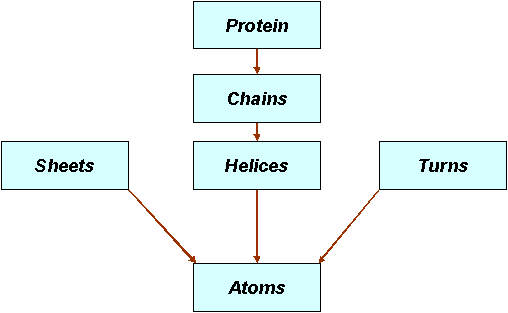|
(See also dynamic shape representations)
The three dimensional structure and properties of molecules determine their functional behavior and interaction with
other molecules. Since proteins are seen to be flexible, and have differing
properties including fields at different configurations, a mere rigid body
interaction simulation does not suffice. Hence, we need to perform simulations
with flexible models.These models help in both calculations and visualization of protein docking in
an adaptive manner. Bonds between different structures can be given different
degrees and ranges of freedom, and this tree like structure lends itself to
faster animation calculations than a full n body simulation.
Hierarchical data structure to hold a protein which can be defined naturally in this manner.
class GroupOfAtoms
{
public:
GroupOfAtoms( );
virtual ~GroupOfAtoms( );
ExpandableArray<GroupOfAtoms>
m_SubGroups;
ExpandableArray<Atom> m_Atoms;
ExpandableArray<Bond> m_Bonds;
};
|
The protein descriptions are parsed into the above recursive structure, with
the following graph.

|
Hierarchical models are constructed from the new data structure in various
ways for visualization.
- The union of balls representation has been extended to allow for a tree
like representation, in which atoms are collapsed into larger primitives,
preserving some error bounds.
- Adaptive isocontouring and dynamic adaptive isocontour visualization are
some of the tools developed for this purpose.
- Hierarchical splatting softwares have been developed to render the
functions in an adaptive manner.
- A new data structure for representing Adaptive meshes has been presented.
C. Bajaj, V. Pascucci, R.
Holt, A. Netravali.
Dynamic Maintenance and Visualization of Molecular Surfaces
Fourth issue in the special series of Discrete Applied Mathematics on
Computational Molecular Biology
Sanner, M., and Olson, A.
Real-time surface reconstruction for moving molecular fragments.
Pacific Symposium on Biocomputing'97, 1996, R.Altman, A.Dunker, L.Hunter, and
T.Klein, Eds., World Scientific Press, pp.~385-396.
Sanner, M., Olson, A., and
Spehner, J.
Reduced surfaces: An efficient way to compute molecular surfaces.
Biopolymers 38, 1996, 305-320.
Lotan, I., Schwarzer, F.,
Halperin, D., and Latombe, J.C.
Efficient maintenance and self-collision testing for kinematic chains.
Proc. 18th ACM Symposium on Computational Geometry, 2002, pp.~43-52.
Halperin, D., Latombe, J.C.,
and Motwani, R.
Dynamic maintenance of kinematic structures.
Robotic Motion and Manipulation, J.P. Laumond and M.Overmars, Eds. A. K.
Peters, pp.~155-170.
Finn, P., Halperin, D.,
Kavraki, L., Latombe, J.C., Motwani, R., Shelton, C., and Venkatsubramanian, S.
Geometric manipulation of flexible ligands.
Applied Computational Geometry: Towards Geometric Engineering, M.C. Lin and
D.Manocha, Eds., vol.~1148 of Lecture Notes Comput. Sci Springer-Verlag, 1996,
pp.~67-78.
|